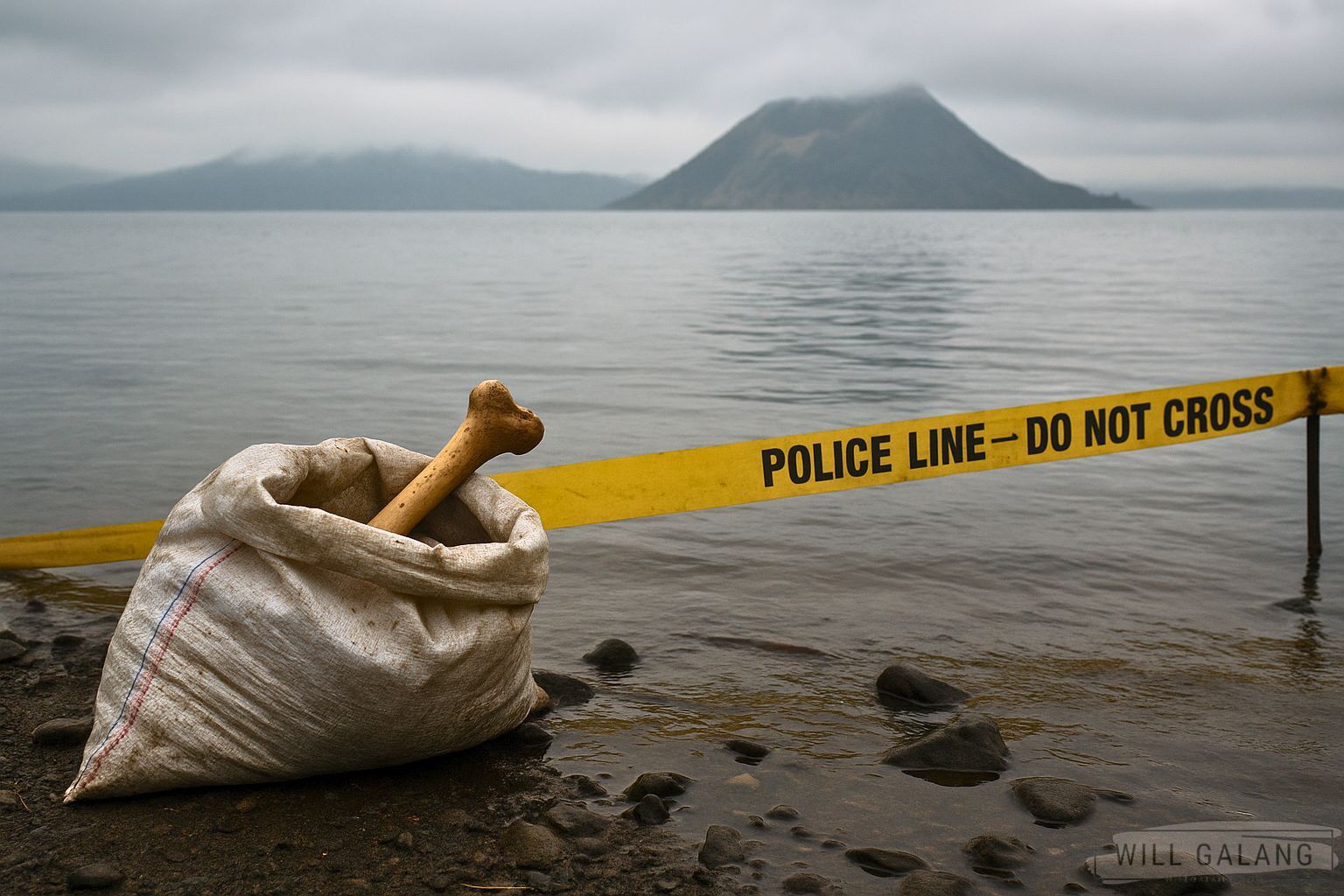
Taal Bones: Are We Looking at Evidence or Theater?
I’ve been somewhat following the recent discovery of sacks allegedly containing human bones pulled from Taal Lake, and like many, I have questions. Not wild theories—just honest, grounded questions that no one seems to want to answer directly.
We’re being told these sacks might be connected to the long-unsolved disappearance of several sabungeros—cockfighting aficionados—who vanished without a trace more than four years ago. Now suddenly, human remains surface in the volcanic waters of Taal? On paper, it sounds like a major breakthrough. But look closer, and the story starts to feel murky.
Let’s start with the sacks.
These were supposedly sitting in the lake for years. But based on the photos making the rounds online, they don’t look like they’ve been through four years of acidic water, geothermal activity, or even basic natural wear. No significant fading. No algae. No heavy sediment buildup. In fact, they appear unusually clean—like they were dumped only recently.
That raises a difficult question: Were these sacks planted? It’s not a wild accusation. It’s a reasonable line of inquiry. Taal Lake is mildly acidic due to volcanic activity. While not as corrosive as acid rain, it’s harsh enough that any plastic sack left submerged for years should show obvious signs of decay. Fraying. Discoloration. Partial disintegration. And if the sacks don’t show that, forensic investigators should be the first to acknowledge it—clearly, publicly, and scientifically.
But the Philippine Coast Guard (PCG) has firmly denied any tampering. In a statement today, PCG spokesperson Capt. Noemi Cayabyab said, “This is a formal, coordinated operation. The PCG categorically denies that the sacks found were planted…”
They point out that five sacks have been recovered—two containing suspected human bones, one with charred remains, and two filled with stones—all located approximately 20 meters apart.
So, the official line is: This is no performance, but the visuals of the clean sacks still demand scrutiny.
Then there’s the issue of the bones themselves.
If these are human remains, forensic science should tell us:
- How long they’ve been dead.
- Whether they’ve actually been submerged.
- Whether they match any of the missing sabungeros.
Several forensic experts say this may still all come together. A pathologist noted the acidity and environment could strip flesh quickly, but that bones can still be analyzed for identification and DNA. Meanwhile, the Department of Justice has confirmed that remains found in the white sack are undergoing tests to verify they’re human and—if so—matched to missing persons.
But here’s the truth: Finding human remains doesn’t automatically link them to the sabungeros. Taal Lake is vast and deep. It has held countless secrets long before this case. If the bones aren’t a match, then either this is an unrelated tragedy—or, worse, we’re looking at manufactured evidence.
So far, the headlines are outpacing the evidence. And in that gap, public speculation fills the void.
I’m not trying to stir conspiracy. I’m just pointing out what seems obvious: If the sacks don’t look like they’ve been underwater for years, maybe they haven’t. If the bones don’t match the sabungeros, then the story is even bigger—or stranger—than we first thought.
What matters now is transparency. The public deserves to know what the forensic tests reveal—not vague statements, but hard facts. How degraded are the bones? Is there DNA? Do the sack conditions match long submersion in a volcanic lake?
We don’t need drama. We need answers. Because if this really is evidence in a years-old mystery, it deserves to be handled with care. And if it’s something else—fabricated or otherwise—then someone is playing a very dark game with public trust.
Either way, the truth needs to surface—not just the sacks.
Endnotes:
- PCG denies planting evidence in Taal Lake dive ops. Tribune.net.ph. July 13, 2025.https://tribune.net.ph/2025/07/13/pcg-denies-planting-evidence-in-taal-lake-dive-ops
- Retrieved sacks’ contents from Taal Lake must be properly handled, says forensic expert. GMA News. July 13, 2025.https://www.gmanetwork.com/news/topstories/nation/952430/retrieved-sacks-contents-from-taal-lake-must-be-properly-handled-says-forensic-expert/story
- PCG denies Taal Lake sack evidence was planted in missing sabungeros case. The Filipino Times. July 13, 2025.https://filipinotimes.net/latest-news/2025/07/13/pcg-denies-taal-lake-sack-evidence-was-planted-in-missing-sabungeros-case
- Can bones found in Taal Lake still be identified? Forensic pathologist answers. ABS-CBN News. July 11, 2025.https://www.abs-cbn.com/news/nation/2025/7/11/can-bones-found-in-taal-lake-still-be-identified-forensic-pathologist-answers-0931
- DOJ: Possible human bones near Taal Lake amid search for sabungeros. Inquirer.net. July 11, 2025.https://newsinfo.inquirer.net/2080826/doj-possible-human-bones-near-taal-lake-amid-search-for-sabungeros
- Murder mystery of missing Filipino cockfighters takes new twist. The Times (UK). July 12, 2025.https://www.thetimes.co.uk/article/murder-mystery-missing-cockfighters-philippines-mb26v9bq8
